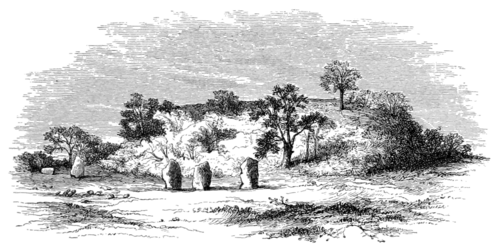That at Knowth has never been carefully measured, nor, so far as I know, even described in modern times. At a guess, it is a mound 200 feet in diameter, and 50 to 60 feet in height, with a flat top not less than 100 feet across. It is entirely composed of small loose stones, which have been extensively utilized for road making and farm buildings, so that the mound has now a very dilapidated appearance, which makes it difficult to ascertain its original form; and so far as is known, its interior has not been accessible in modern times. Petrie identifies it (p. 103) with "the cave of Cnodhba, which was searched by the Danes on an occasion (A.D. 862), when the three kings, Amlaff, Imar, and Auisle, were plundering the territories of Flann, the son of Conaing. If this is so, its entrance ought not to bo difficult to find, but the prospect of the explorers being rewarded by any treasure or object of value is very small indeed.
Less than a mile from this one is the larger and more celebrated mound of New Grange. It is almost certainly one of the three plundered by the Danes 1009 years ago. No description of it has anywhere been discovered, prior to the time when Mr. Llwyd, the keeper of the Ashmolean Museum at Oxford, mentioned it in a letter dated Sligo, 1699.[1] He describes the entrance, the passage, and the side chapels, and the three basins as existing then exactly as they do now, and does not allude to the discovery of the entrance as being at all of recent occurrence, though
- ↑ Rowland's 'Mona Antiqua.' p. 314.

